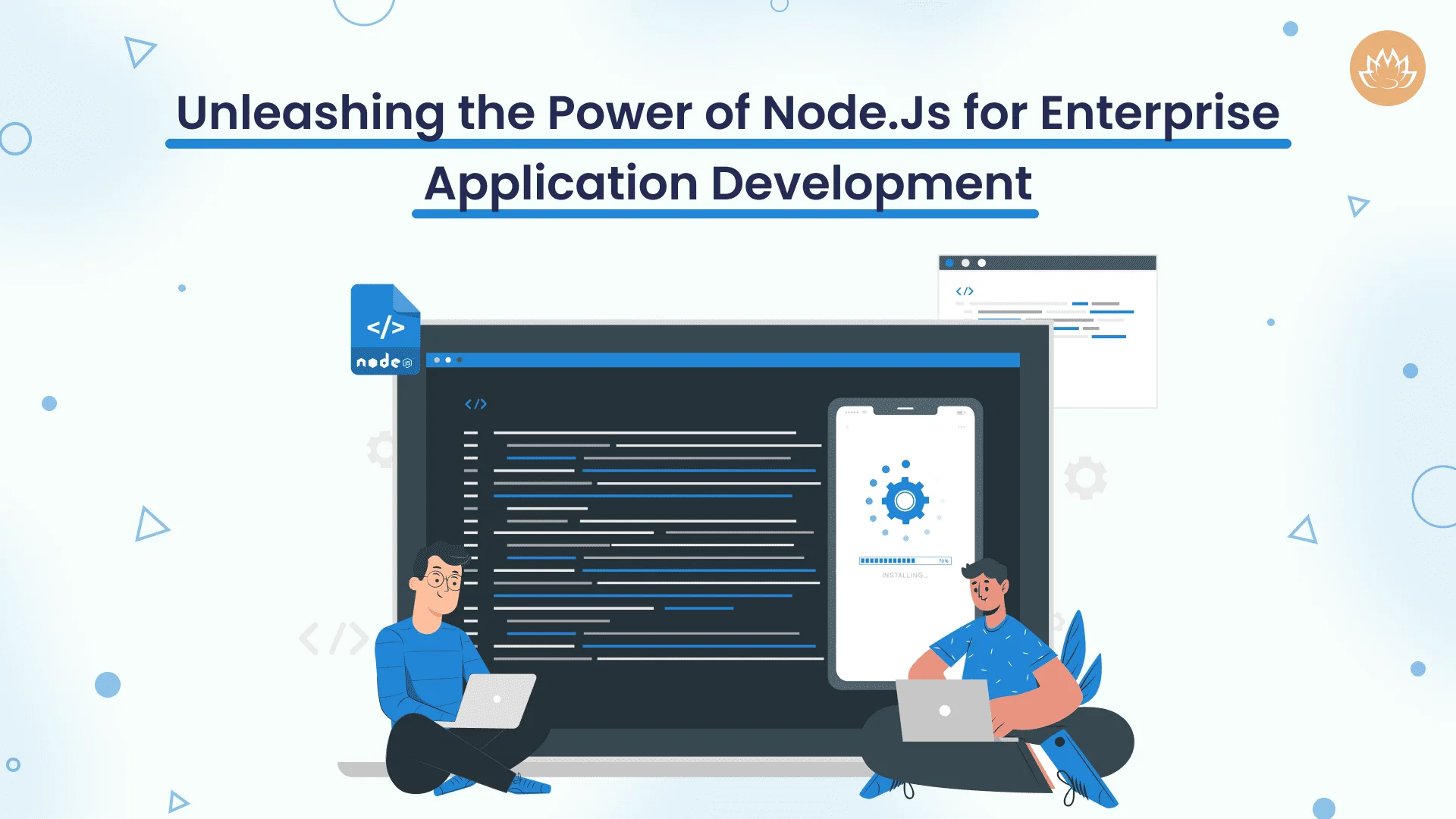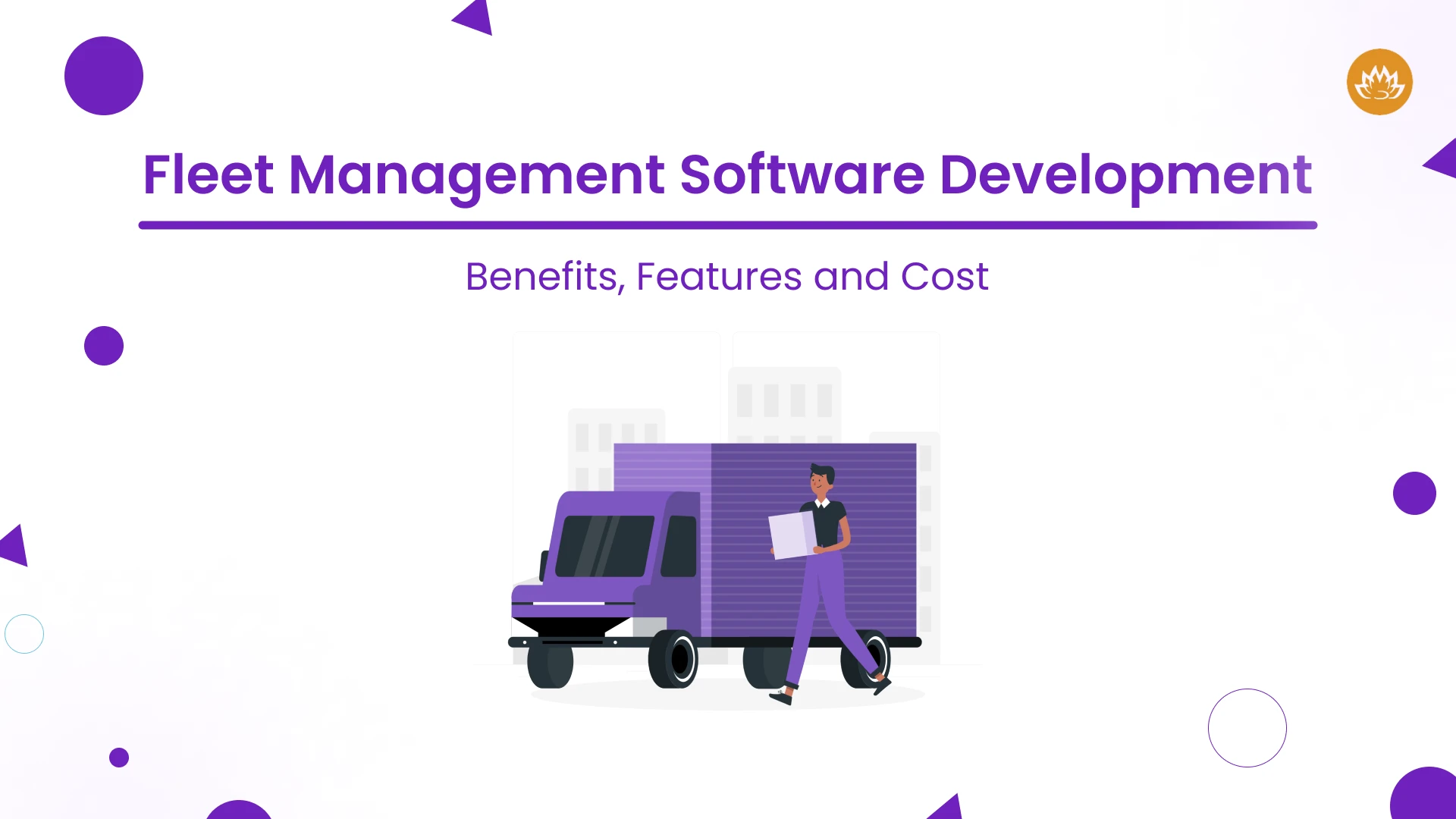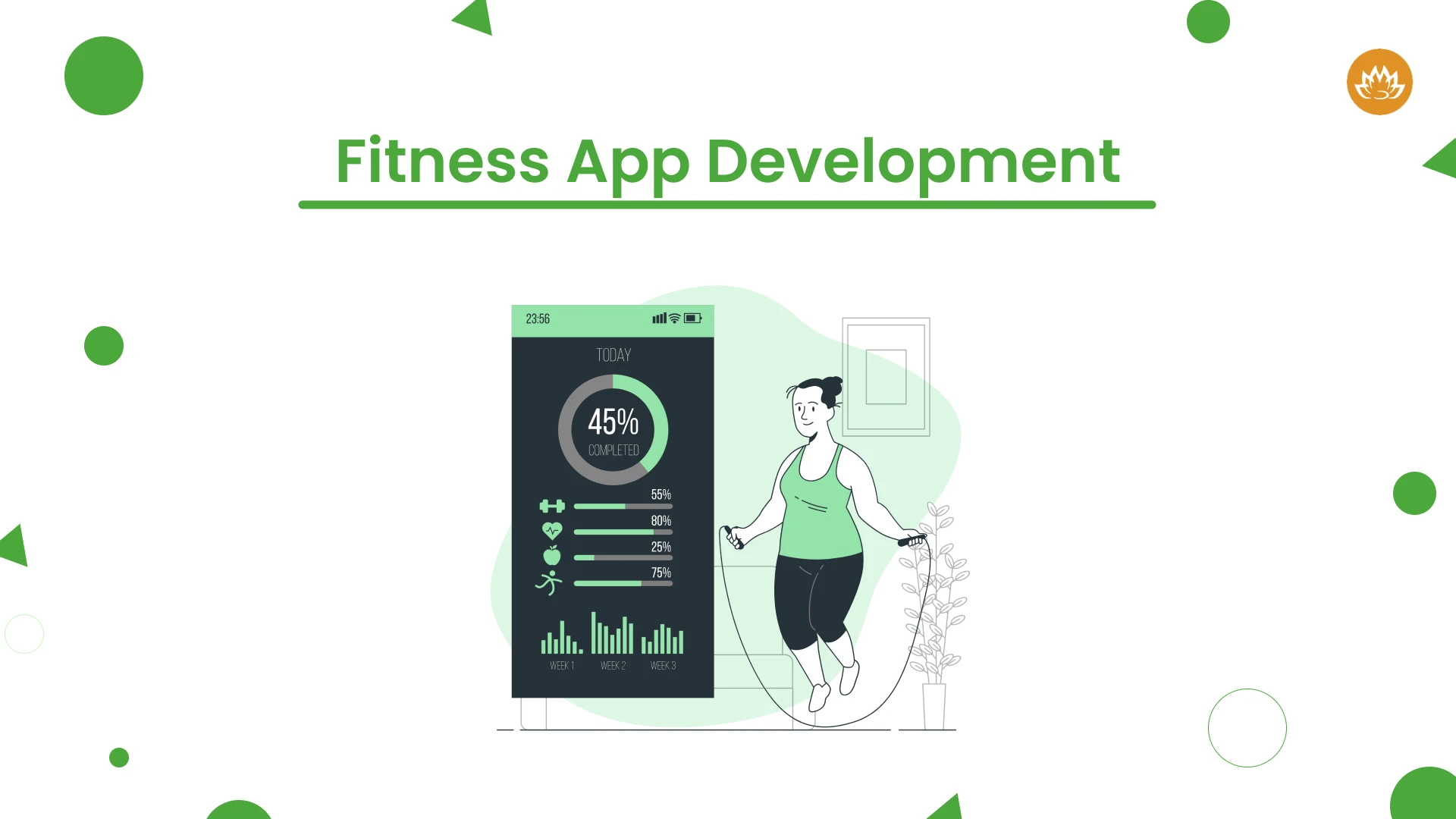Some of the world’s top brands and companies have used NodeJs to build their enterprise apps. Although there are so many technologies at their exposure, NodeJs stands out as the most user-friendly, highly scalable, and top-performance option for developing enterprise applications. Developers consider it the best platform to maintain quality standards for business operations, ensure data privacy, and expand employees’ network. Equipped with the most exclusive server environment, it simplifies the enterprise app development process.
98% of Fortune 500 companies like LinkedIn, PayPal, Netflix, and Microsoft use NodeJs for building scalable network applications. The rapid growth and usability of NodeJs in building small and large-scale enterprise applications has enabled businesses to explore new horizons for enhancing productivity and profitability.

What is NodeJs?
NodeJs is an open-source, cross-platform server environment that runs JavaScript codes outside the web browser. Developers use JavaScript and Node.js to write command-line tools that run server-side scripts. It produces dynamic web page content to give enhanced user experiences. Its asynchronous programming system enables single-programming web application development for both the server and client side.
Developed on Chrome’s V8 JavaScript engine, the server environment functions on a data-driven, non-blocking I/O model that renders scalable, effective, and lightweight operations. Used to build real-time enterprise applications, NodeJs uses push technology over WebSockets.
NodeJs Stats
– 6.3 million websites in 2023 were using NodeJs and considered it the most efficient tool for web development.
– 70% of global businesses believe NodeJs increases developer productivity
– All NodeJs versions show a staggering download growth with a 40% increase every year.
Reasons Why NodeJs is Gaining Popularity
- Large and active community with 80k plus stars and 4k contributors on GitHub. The Community contributes to constant improvement, and extensive support, providing regular updates.
- Highly concurrent and scalable in building real-time applications.
- Microservice architecture, lightweight design, and asynchronous capabilities to build enterprise applications.
- Can develop cross-platform enterprise applications with great adaptability and effectiveness
Overview of NodeJs Enterprise Application Development
You need fast and scalable enterprise apps that can manage large amounts of traffic and give millions of consumers a flawless user experience. With NodeJs, you can decrease app startup time, amplify its launch time, and offer consumers more responsive applications. Over the years, NodeJs has become the most powerful tool for brands by achieving quick time-to-market and giving a wider edge over their competitors to grab profitable opportunities. For enterprise app development, NodeJs has become a game-changer as companies can find more benefits that contribute to shaping the future of their business.
Top Features of NodeJs That Contribute To Building Winning Enterprise Applications
Wide NPM Ecosystem
You can access a huge selection of third-party tools, modules, and libraries with more than 1.3 million packages in the NPM repository. You can perform seamless development workflows, get optimized build time, and reduce costs. It offers ready-to-use solutions for complex development procedures by eliminating the need to reinvent the wheel for common web app feature requirements. You can easily install NPM and access these package modules for free.
Non-blocking I/O
The non-blocking I/O module allows the multi-tasking of a single process in the event loop with ‘non-blocking commands’. It also helps serve multiple requests simultaneously and its API eliminates the wait time of I/O operations for a response. The thread continues to work on other tasks while I/O operations are completed. This feature boosts app efficiency, enhances performance, and controls memory overhead.
Event-Driven Architecture
NodeJs uses an event-driven paradigm with triggered I/O actions that respond to events like user interactions or system responses. With ‘EventEmitter’, NodeJs facilitates the seamless handling of concurrent queries through a decoupled architecture, enabling faster and scalable enterprise web applications. The event-driven module performs a multi-tasking I/O process that can manage a high volume of requests and data-intensive queries, with zero memory overheads. With this feature, you can build enterprise-running applications for video and audio streaming, gaming, real-time chats, stock exchange, and collaboration.
Cross-Platform Compatibility
The cross-platform compatible architecture of NodeJs enables enterprise web apps to run on multiple devices and environments without switching technologies or hiring additional resources. As the efficiency improves, your enterprise app can expand user reach and improve ROI.
EJS for Server-Side Rendering
EJS (embedded JavaScript template) is used for server-side rendering of applications. Key aspects that increase NodeJs module efficiency are simple syntax, active development support, plain JavaScript structure, quick execution process, and seamless debugging mechanism. In addition, this feature enables building applications that can manage, maintain, and process large amounts of data and complex business logic.
Microservices Compatibility
NodeJs modular component-based architecture makes compatible microservices. It breaks down large-scale applications into small modules providing upgrades, easy optimization, and additional features without hampering other components. As a result, it increases agility and resilience.
Asynchronous Model
The asynchronous Model of NodeJs can manage heavy loads of queries. The asynchronous callback functions facilitate processing and responding to client requests. All this becomes possible without blocking the thread, enabling multiple user interactions and avoiding disruptions.
Single-Threaded Event Loop
The single-threaded event loop architecture can handle multiple concurrent clients efficiently through a JavaScript thread. In the form of advantage, this improves system performance, minimizes errors, simplifies multi-platform coding, and reduces development costs.
Real-time Communication and Streaming
With NodeJs, you get real-time communication between servers and clients. Technologies like WebSockets and EventSource API help through the process. Supporting bidirectional connections, NodeJs allows instant updates and web application messaging. Considered the best option for businesses, NodeJs can develop interactive and media-rich apps by managing huge files and real-time media processing through seamless data streaming.
Successful Real-time Examples Built With NodeJs
The following case studies are real-time examples built with NodeJs. They are some of the most successful endeavors in the tech space and have harnessed the power of NodeJs to obtain phenomenal results.
PayPal
PayPal has pioneered the online payment system, changing consumers’ online purchasing patterns. Its 377 million active users account for a massive success on the global front, making it an undisputable billion-dollar brand. PayPal chose NodeJs to build its core corporate apps and get a higher level of growth.
Challenges:
– Language constraints between back-end engineering and front-end teams blocked PayPal from getting consistent innovative solutions for developing apps that can meet all types of user requirements.
– Difficulty in handling high volumes of traffic and requests causing scalability issues for the enterprise app
– Could not quickly build and deploy new features and services into the app
Heavy developer machines
Solutions:
– Used NodeJs architecture leveraging its event-driven, non-blocking I/O model that allowed handling high volumes of concurrent connections and transaction requests with zero downtime.
– From monolithic architecture, it got transferred into microservices reflecting modular design that can build features and services rapidly.
– Used the extensive NodeJs package ecosystem and the power of its active community for enhanced development-side productivity
Results:
– PayPal became 2x faster with fewer people, fewer lines of code, and 40% fewer files as compared to Java-based application
– Served pages 200ms faster in comparison to the previous version, enabling a 35% decrease in average response time
– Could handle requests 2x times faster per second processing speed.
NodeJs empowered PayPal to outperform its competitors in the market of large-scale enterprise applications. It performed secure online transactions across the globe in 25+ currencies. Today it is working as a power-packed tech stack turning into a multi-billion-dollar company.
Netflix
Netflix is the world’s largest video streaming app with around 232.5 million paid subscriptions from 190 countries. It has transformed content consumption, including movies, web series, and TV series with consistent investment in innovation and technology. Kim Trott considers NodeJs as the most attractive option to scale Netflix as it could align well with the skills of UI engineers.
Challenges:
– Too many vertical scaling concerns with their monolith JVM-based system
– 40-minute long startup time
– Low speed in building new features and additions
– Redundant context switching mechanisms between front-end and back-end architecture
– Heavy developer machines
– Needed a solid mechanism that can serve twice for client-side and server-side: write code, data access, debug, render, etc.
Solutions:
– Adopted full-stack JavaScript to eliminate issues of context switching and maintain consistency throughout the architecture
– Harness its event-driven I/O non-blocking model for managing high volumes of traffic.
– The transition from monolithic architecture to microservices architecture
– Scaled up the production with its tried and tested NPM registry modules
Results:
– Moved from single-page application helping reduce load time to roughly 60 seconds
– Optimized build times improving the scope of work on feature innovations
– Can handle massive volumes of traffic and data with efficiency
– Enhance the level of possible customizations in its user interfaces for each user
– Could deliver real-time updates to users’ feeds and notifications
– Helped in performing A/B feature testing easily
LinkedIn harnessed NodeJs for the mobile app’s backend optimization to enhance its performance in handling high traffic volume and millions of concurrent connections. It could scale new features and update existing modules, producing quick development cycles with high-quality maintainability.
Challenges:
– The basic mobile architecture was built on Ruby on Rails which often ran into trouble while working with a lot of micro connections, causing scalability concerns.
– Not optimized for JSON translation
– Slow and memory-intensive module
– Working with a multi-processing model for concurrency handling leads to memory bloats and performance issues.
Solutions:
– Replaced synchronous Ruby on Rails with an asynchronous event system of NodeJs to execute multiple tasks simultaneously, handling scalability issues and performance gaps
– Handled heavy volumes of traffic and concurrent requests with a non-blocking I/O model by preventing blocking of event loop
– Harnessed its single-threaded loop structure to handle lower memory overheads
– Efficient caching implementation to frequently access data for enhancing app performance by a lesser number of database queries.
– Microservices architecture that can break down the application into smaller manageable components to scale and maintain
Results:
– Double traffic handling capacity
– 10x lesser number of machines for service hosting
– The newer version has a 20x faster running mobile application
– Servers reduced from 30 to 3
– 8x better performance by lower memory overhead
– Enhanced unity and uniformity between backend and frontend mobile teams by combining into a single unit
– Better coding experience due to JavaScript
Uber
Uber is the revolutionizing ride-hailing technology that completely transformed its business with the power of NodeJs. It created and expanded its corporate apps with operations at over 900 metropolitan regions worldwide, having millions of daily trips.
Challenges:
– Could not deliver real-time updates to drivers and riders
– Technology challenges in managing vast amounts of geographical data and matching riders with nearby drivers
– Could not handle enormous traffic fluctuations in peak hours and difficulty in handling high concurrency that could ensure seamless user experience.
Solutions:
– Adopted NodeJs event-driven architecture to facilitate real-time communication between drivers, riders, and the Uber platform, ensuring rapid updates
– A lightweight and non-blocking I/O model could handle a large number of concurrent connections, making smooth operations during peak demand.
– Could manage complexities of location-based services effectively with accurate and efficient matching of riders
Results:
– Enabled instant rider-driver matching and reduced wait times to ensure quick pick-up for users
– Low latency for real-time updates and interactions, enhancing user experiences
– Can handle high levels of concurrent requests, ensuring platform stability and reliability at peak hours.
– Streamlined the development processes, facilitating Uber engineers to work with a familiar language for both, front-end and back-end tasks.
Benefits of Using NodeJs for Large-Scale Enterprise Applications
High Performance
The non-blocking nature of NodeJs can handle I/O operations efficiently. The server can respond to requests quickly with improved application performance and reduced latency. It can manage real-time applications such as chat and collaboration tools, maintaining low latency.
Scalability
Built on the V8 JavaScript engine, NodeJs is suitable for building applications that require handling heavy traffic and supporting a large number of users.
Rich Package Ecosystem
Vast and active community contributing to NPM repository providing a wide range of open-source libraries and modules. Can build complex features with great speed and efficiency.
Single Language for Frontend and Backend
JavaScript for both frontend and backend development streamlines the development process and reduces the learning curve of the team, promoting code reusability.
Rapid Development
The lightweight nature of NodeJs suits well for agile development methodologies, making various modules available. It ensures faster development cycles and quicker time-to-market for enterprise applications.
Easy to Learn and Adopt
NodeJs is easy to learn and adapt as JavaScript is the most widely used programming language, making developers familiar with it.
Large Community and Support
The large and active community of developers and enthusiasts who can find solutions to their problems receive community support and access documentation.
Microservices Architecture
Small memory footprint and ability to handle concurrent connections make NodeJs ideal technology for building individual microservices.
Cloud-Native Readiness
Container-friendly design of NodeJs makes it a natural fit for deploying applications on cloud platforms like AWS, Azure, and Google Cloud.
Best Practices of NodeJs for Enterprise Application Development
1. Follow a modular and organized code structure by breaking your application into smaller modules, enabling easy code maintenance, testing, and understanding.
2. Make the most of its asynchronous programming feature
3. Deploy robust error-handling systems throughout the codebase to avoid unhandled exceptions
4. Practice strict security measures by sanitizing user inputs, data validation, and using parameterized queries to prevent SQL injection attacks.
5. Optimize your code by application profiling, identifying bottlenecks, and addressing them accordingly.
6. Practice comprehensive logging throughout the application for tracking errors and debugging issues.
7. Perform load testing to ensure your application can handle high traffic and concurrent users.
8. Use environment variables for configuration settings like API keys, database credentials, and sensitive information.
9. Get a version control system like Git for managing your codebase effectively by implementing CI/CD for automated testing and deployment processes.
10. Use valid SSL certificates to encrypt traffic and protect user information
11. Optimize database queries and use caching strategies to reduce database overload
12. Maintain details documentation for your codebase, APIs, and configuration
13. Employ static code analysis tools for identifying potential issues, security vulnerabilities and code smells.
Why Choose Whitelotus Corporation as NodeJs Development Partner?
Whitelotus Corporation is the top NodeJs development company offering numerous benefits with NodeJs technology. We are a reputed software development company in India and abroad, having a proven track record of delivering high-quality services and solutions for our clients worldwide. We are well-known for our below services:
– High expertise in NodeJs Development Services
– Dedicated, skilled, and experienced NodeJs Developers
– Customized NodeJs-based solutions to match your unique needs
– Cost-effective outsourcing solution
– Efficient handling of the project enabling faster time-to-market
– Better quality assurance to meet the highest standards
– Ongoing support and maintenance
– Transparent communication with clients about the progress of the project
– Passionate about innovation and adopting the latest trends.
FAQs
1. Can I create good enterprise applications with NodeJs?
Yes, NodeJs is best suited for developing enterprise applications. At Whitelotus Corporation, we harness the best features of NodeJs and can help you handle the demands of real-time, large-scale, responsive, and data-intensive enterprise applications.
2. Is it possible to integrate NodeJs with other commonly used technologies in enterprise environments?
3. What are the potential challenges of using NodeJs enterprise app development?
– There may arise complexities in handling asynchronous code, leading to callback hell to make code harder to read and maintain
– Sometimes it becomes difficult to find experienced NodeJs developers
– NodeJs is not suitable for all types of scenarios like applications that need extensive computational processing.
Author
-

Sunil is a result-orientated Chief Technology Officer with over a decade of deep technical experience delivering solutions to startups, entrepreneurs, and enterprises across the globe. Have led large-scale projects in mobile and web applications using technologies such as React Native, Flutter, Laravel, MEAN and MERN stack development.
View all posts












